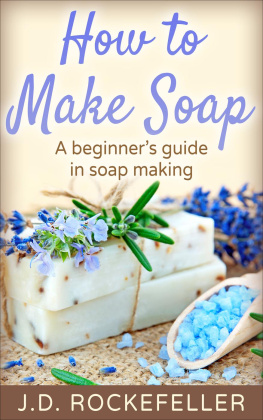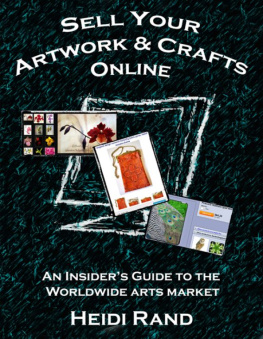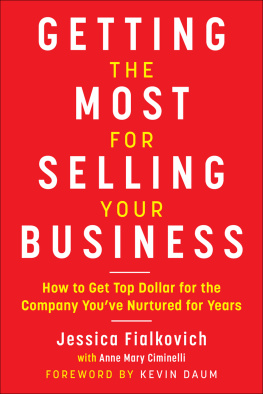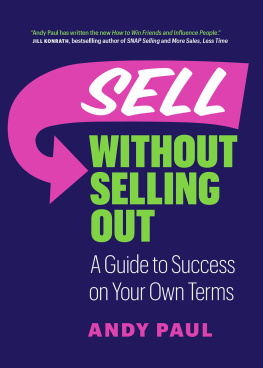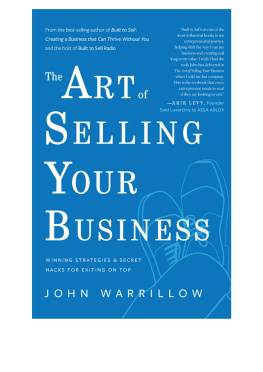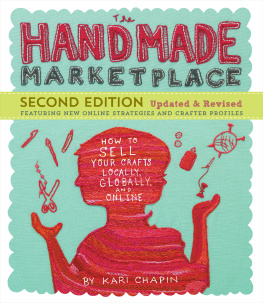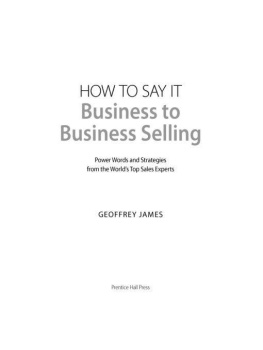HOW TO BE A SUCCESSFUL ENTREPRENEUR SELLING YOURART

J.D.ROCKEFELLER
~~~
Smashwords Edition
Copyright 2015 by J.D. Rockefeller. All RightsReserved.
No part of this publication may be reproduced,distributed, or transmitted in any form or by any means, includingphotocopying, recording, or other electronic or mechanical methods,or by any information storage and retrieval system without theprior written permission of the publisher, except in the case ofvery brief quotations embodied in critical reviews and certainother non-commercial uses permitted by copyright law.
Smashwords Edition, License Notes
This ebook is licensed for your personal enjoymentonly. This ebook may not be re-sold or given away to other people.If you would like to share this book with another person, pleasepurchase an additional copy for each recipient. If youre readingthis book and did not purchase it, or it was not purchased for youruse only, then please return to your favorite ebook retailer andpurchase your own copy. Thank you for respecting the hard work ofthis author.
Table of Contents
Introduction
An artist doesnt need to starve for theirpassion. Outdoor shows, brick and mortar locations, the internetand the availability of more venues has made it easier for creativeentrepreneurs to showcase and sell their work. Selling artwork is,however, a competitive endeavor, and that has forced artists toproduce beautiful and quality work that is competitively priced. Tobe successful with your ambition, you need to crunch the numbers,gradually build your business and create sales in low-cost venuesbefore you move on to bigger arenas.
Selling artwork or anything for that matteris an important business skill. Not everybody possesses the gift ortalent to venture into the life of selling. However with this inmind, we should at least be able to sell one thing: and thatsourselves. For an entrepreneur, your ability to convince potentialbuyers that you are someone capable of doing business with is vitalfor success.
Theres no secret between the connection ofart and money. A shocking idea is one that states that no artist isdestined for starvation and poverty. If you are a passionate andcreative artist, you can make some good money from your work, feelgreat about it and generate a massive following of supporters foryour career. And thats true!
You may ask yourself why so many artistsfalter in the quest to make a living from art?
The positive thing however is that manyartists fail simply not because they dont have the creativity ortalent to produce great work, but rather because they havent beenadequately trained to represent themselves properly to buildcustomer bases and actually sell their amazing work.
If you look at it this way, the olden day wayof generating fame and fortune as an artist was about receivingfavors of gatekeepers. Starting with patronage systems in Europeall the way to museums and galleries of our modern days. The oldenway was simply about groveling for endorsements for outsiders, whoat the time collected massive percentages of what artists earned inexchange for representation. This was of course very effective forthe gatekeepers.
Although the olden day method still works fora fewer number of artists, the drawback is its zero-sum game, whichmakes it hard to break in. The good thing is that there are moreclear alternatives.
Chapter One ---- Taking Time to Think About Marketing YourArtwork
Taking a considerable amount of time to thinkabout marketing your artwork will spell the difference betweensuccess and failure. When looking at marketing your artwork, butnot sure where to start; the following tips should help you promoteyour work.
Create An Amazing Portfolio
Building a well photographed and organizedportfolio detailed information and high-resolution images of yourart will be your first step in establishing an amazing portfolio.As an artist, you wont only be interested in showcasing your work,but also to tell your audience about what inspired you, when it wascreated, what you used to create it and all the stories behindit.
Enter A Showcase
Think of it; which other events couldpossibly give you more visibility for your art other than ashowcase. Most popular events attract thousands of viewers and ifyou find your work mingling with other great pieces of art, itcould boost your popularity and lead to sales. Find out when thenext exhibition is coming to your area and see how you can get yourwork slotted in. The more your visibility, the more events you getinvited to and the opportunities are endless.
Make Your Artwork Search-Friendly
Quite often, art collectors are veryparticular about the next piece of art they purchase. Somecollectors are inspired by certain medium while some are interestedin specific subjects you just cannot guess or anticipate whatcollectors will be interested in or how they can be able to findyou. One of the best practices to employ is to write good,informative descriptions about your art, specify which category itfalls under, medium, size and subject of your art. If you take yourtime being precise about your artwork, then collectors will be ableto find you easily.
Be Part of A Community
Find out if there are any exhibitions orevents that you would be interested in taking part in. Are thereany charity events taking part in which you would like to auctionyour artwork? Whats currently taking place in the art world? Whoare the most influential people in the industry and how can youcontact them? Awareness is something important when it comes toexposing and promoting your artwork. Take part in local communityevents, join social media networks and most of all create a websitewhere people can see your work.
Collaborate and Keep in Touch
Networking is fun and extremely beneficial.It is important to make connections and forge contacts in all theevents you attend. Get yourself involved in many art discussions,make friends and engage with them. These friends will later makepart of your enthusiastic team of art marketers for you.
Chapter Two ---- Discovering Where Your Art Belongs
Just as previously mentioned in theintroduction section, no talented and creative artist needs tostarve. While the growth of the industry as generated competitionand increased the need to create quality work, as an artist youneed to discover where your art belongs. If you dont know how todiscover then your chances of success will be minimal. Make sureyou can clearly explain your portrait in great detail, to theextent that youll be able to convince just about anycollector.
The following are essential steps to followin order to successfully sell your artwork:
Step 1
Determine the amount of profit youll need toconsider yourself successful. This amount will of course varyaccording to different artists. Some will be content with amoderate income enough to supplement their daily job while want tomake a lot of money and live exclusively from their creativebusiness. Being able to determine the profit you want to generatewill help you know how much to produce, your level of markup andhow often to produce.
Step 2
Ascertain your costs. For you to make aprofit from your artwork, youll need to know much youll spend onmaterials, promotion and other expenses. Keep your receipts fromevery purchase and track all expenditure as it occurs. Dont forgetother overheads like income tax and studio costs. Depending on thesize of your entity and your current state, you may also berequired to collect and remit sales tax.



